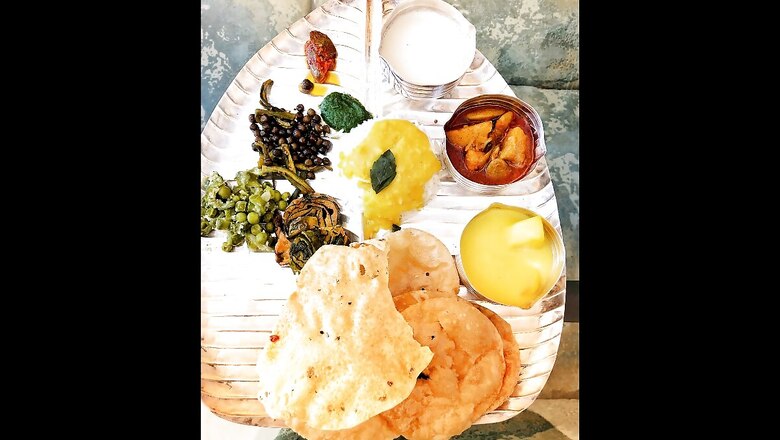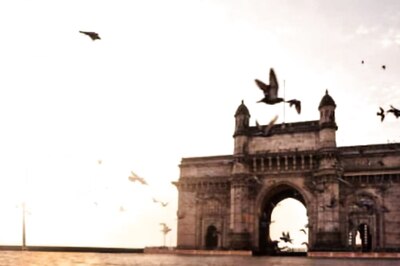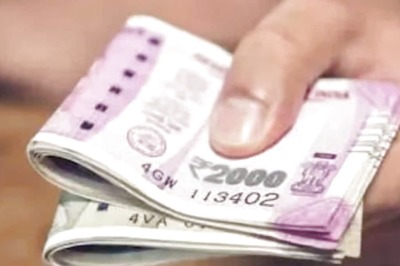
views
It’s also the first food that comes to mind when you’re hungry. It’s the first food you feed a baby. It’s the first food you eat when you’re ill, it’s also the first food you eat when you are celebrating. It’s the first refuge when you’re alone, and it’s the first food you miss, when you think about your mother, or even your grandmother.
So then, what is Varan Bhaat? It’s daal and rice. But you cannot incautiously dismiss Varan Bhaat as the Maharashtrian version of Daal Chawal. As simple as it may sound, Varan Bhaat transcends class, caste, rank, society and belief. The most elaborate meal in a wealthy Maharashtrian home will always begin with Varan Bhaat, while the only food in the plate of the needy will also be Varan Bhaat. Varan Bhaat is the very identity of the Maharashtrians.
Food of the King and Masses
When we were growing up, before our lunches became luncheons and supper turned into sprees, a typical meal at our home would be two kinds of fish, one fried and the other with gravy. One meat dish, either kheema or mutton. Something fried, like bhajias stuffed with either prawns or bananas. One pulse, like vaal or chavli or moong or matki or chana, and chapatis. But irrespective of what else was cooked, there was always Varan Bhaat. Not just Varan Bhaat, but ‘Varan Bhaat Toop’. Let me explain. Sada (meaning ‘plain’ or ‘simple’) Varan is toor daal (split pigeon peas in English, or arhar dal in Hindi) cooked till it is soft enough to be mashed smooth. It’s only flair and seasoning— asafetida (heeng), jeera, salt and a pinch of sugar. No onion, no garlic and no tempering. That’s it.
ALSO READ | What The Fork: Like Sindhis, Their Cuisine Too Reflects Adaptability, Writes Kunal Vijayakar
You serve yourself some hot steaming rice, pour the Varan over it. While most of my family liked the Varan really thin, I liked it nice and thick. On top of the rice and Varan, a few tablespoons of melted ghee. Melted ghee is called Toop. Hence, Varan Bhaat Toop. Then with your fingers, you muddle it all up and while your fingers are still smarting from the heat, you start shoveling it into your mouth. Its simplicity bursts in your mouth with the most complex flavours; there’s the velvetiness of the daal, the pungency of the asafetida, the mild aromatic bitterness of turmeric. How often do you actually taste turmeric in food? Here you do, along with the softness of steamed rice with the nuttiness and the roasted taste of ghee.
This simple meal is unpretentious enough to be the mainstay of the masses, and luxurious enough to be relished by a king. I like to mix a little prawn pickle or green chutney with my Sada Varan Bhaat, and if the meal is vegetarian, then a little ‘Panchamrut’ goes great with it. Panchamrut is chutney made with dry fruits and spiced with dry coconut and aromatic garam masala like star anise and cinnamon.
It is Like Coming Home
So eminent is Varan Bhaat’s place in Maharashtrian cuisine that it features not only in your daily ‘taat’ (thaali) but makes prominent appearance even at festivals and religious occasions. The normal ‘Marathmola Taat’ (Maharashtrian Thali) consists of a simple meal of Varan Bhaat, chutney, koshimbir (salad), a wedge of lime, salt, amti, chapati, one sukhi bhaaji and patal (gravy) bhaaji and, if you are rich enough, shrikhand and pooris. But on Gudi Padva or Ganesh Chaturthi, the ‘taat’ is an elaborate affair. On Gudi Padva, a Maharashtrian ‘taat’ will be served on a banana leaf and will include a Sukka Potato Bhaaji, a Bharli Vangi (stuffed spicy brinjal), Hirvya Vatanyachi Usal (green pea curry), a few savouries like alu wadi, papad, pickle, chutney, shrikhand, poori, and Masale Bhaat (a vegetable pulao spiced with garam masala and garnished with nuts). However elaborate this meal may be, but there will also be Varan Bhaat Toop to end the meal.
ALSO READ | What The Fork: How Kunal Vijayakar, Who Grew up in a Fish-eating Family, Fell for the Humble Chicken
At our home on Ganesh Chaturthi, the ‘Naivedya Taat’ (bhog thaali) which is offered to Lord Ganesh is as elaborate. Of course, there will be the usual chutney, koshimbir, wedge of lime, salt, but we include a Kala Vatana Bhendi (black peas cooked with ladies’ fingers), Batatyache Gode (Pathare Prabhu-style potato gravy), Shirali Vatanyachi Bhaaji (ridge gourd with green peas), Paathwad (alu wadi) Anannasache Sambare (pineapple coconut curry), with sweet sev in milk, shrikhand and poori. But there is always Varan Bhaat Toop right in the centre of the thaali.
Not only in the centre of the thali, but at the centre of most Maharashtrian cuisine. Not only is Varan Bhaat Toop part of every meal in a Maharashtrian home, it is actually like coming home.
Read all the Latest News, Breaking News and Coronavirus News here.



















Comments
0 comment